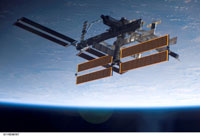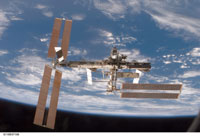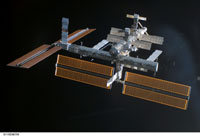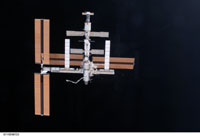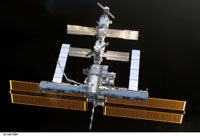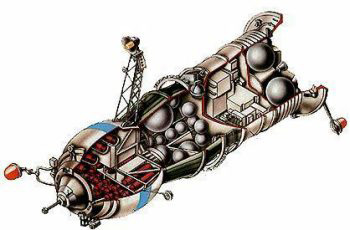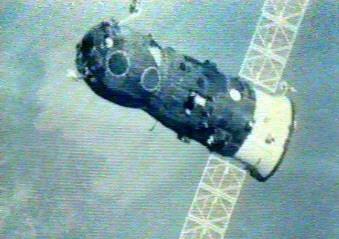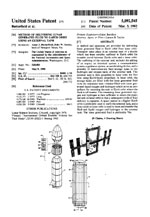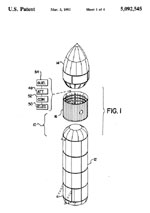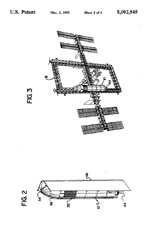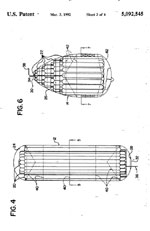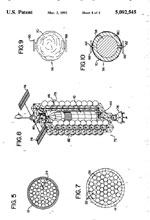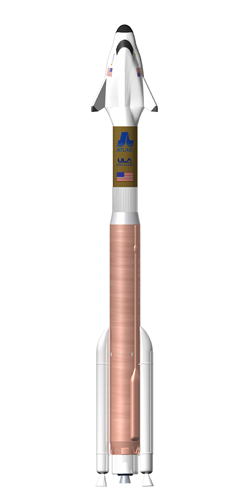|
|
||||||||||||||
|
NOTE: For Current Updates see Boomslanger.com ISS and Shuttle Page .
Yes, it's very pretty. But pretty much useless as well and obsolete, like the Shuttle. Investigations on cosmic radiation and other space physics can be accomplished on unmanned satellites. Onboard systems are failing and can't be upgraded to new technology as it's design prevents easy retrofitting. Electrical as well as other systems hardware would need to be completely replaced throughout the station. What I believe it's main mission is today is a pick-up point for other missions kept under wraps. A Home Depot in space.... ...supplying food, fuel and other equipment to space
stations and craft on secret missions. Of course I can't prove this but
But look at what The NASA channel is showing about it's mission. All you ever see is short, selected video of the station orbiting the Earth in one minute segments. And internal video of personnel banging away on computers or eating Jell-O in zero gravity. NASA has been spouting about the new High Definition Television cameras all over the station, pointing to different areas and Earth. Well, why don't they have a Hi-Def channel for us to see this amazing footage? Or even broadcast any footage? NASA does broadcast the Shuttle launches in HD but...we never get to see any Shuttle footage when it reaches orbit insertion, on it's way to the station or on it's way back. Why?.. Because they're seeing things and doing things they don't want us to see. Whether it be UFO's, other space craft rendezvous, docking at secret space stations, etc.I need to investigate this much more so just chew on that for a while. |
||||||||||||||
| .
. |
||||||||||||||
|
Now it seems to me, this is an extraordinarily large amount of food and water for three people. How would they keep fruit and vegetables from spoiling? You can't freeze fresh fruit and vegetables... Well, you can but freezing would ruin them. And it was fresh, not dehydrated, cooked or freeze dried. Google this and you can find many references to the fresh fruit. Progress-M 59... ...is a Russian automatic cargo carrier that was launched by a Soyuz rocket from Baikonur at 02:12 UT on 18 January 2007, toward the International Space Station. It carried 2.5 tons of food, fuel, water and equipment and docked with the PIRS module of the ISS at 03:03 UT on 20 January. Notice the January flight doesn't break-down the individual weights.How much of that was food and water? And it doesn't take three days to reach the station! All launches are supposed to be timed to make an orbit (a couple of hours at most) and then dock. What was going on in those three days? Progress-M 60... ...is a Russian automatic cargo carrier that was launched by a Soyuz-U rocket from Baikonur at 03:25 UT on 12 May 2007. It carried 45 kg of air, 419 kg of water, and 1.4 tons of dry cargo, 241 kg of fresh fruits and vegetables, 136 kg of medical equipment. It docked automatically with the Zvezda module of the ISS at 05:10 UT on 15 May 2007.(docked on the fourth day) Four days to reach the ISS? There is no explanation for this behavior. La Progress M-60
en órbita (Brazilian)
Progress
M-60 Docked with ISS (Russian)
Progress 60 PDF
This article also shows the timeline. The last three paragraphs show the M-60 was not on an ISS course. There were nine separate major thruster-burns in the three days before docking. Do you see how one can find discrepancies with innocent comments? We are finding alot of information this way. You'll never find anything asking direct questions about a direct subject. One needs to look at the overall picture of any subject and break-down the subtleties and you'll find them. |
||||||||||||||
| .
. |
||||||||||||||
|
I watched the Hi-Def 30 minute broadcast of an "interview" with one of the crew members of the ISS on Discovery HD channel on 08/15/07. (on all this week at different times) Ten minutes of it was on what they eat. No mention of fresh fruit or vegetables. The Commander showed dehydrated food packets, fruit juice packets and everything was in packets. Not a banana, apple or veggie in sight or even mentioned. Now that is intriguing. I also watched the broadcast of STS 118 crew member Barbara Morgan on 08/16/07, talking to Idaho students via HAM radio. One student asked about her favorite food she eats on the station. M&M's was her choice and she explained that all their food was in packets and vacuum sealed. Some was dehydrated and some in cooked form which they could heat-up for meals. Again...no mention of fresh fruit and veggies. So I ask you again... ...where is the fruit and veggies going? And there's alot of it. (Ed. Note: 241 kilograms is 531.3086 pounds... that is over a quarter of a TON of fruit and veggies) Look at the US Patent below and maybe we have an answer...
Russian Segment of ISS Life Support System Neither the Russian nor Americans have ever mentioned
fresh fruit & veggies. The table below shows part of the LSS about
the food storage. Below the table is the complete documents on the Russian
LSS
The Russian LSS is in two parts. Pay attention in Part
2, page 13 &14. That is Section 5 about the food storage and preparation.
Everything is in packets. Most is dehydrated. Some is cooked. But none
of it is fresh.
|
||||||||||||||
| .
. |
||||||||||||||
|
Moscow (RIA Novosti) Aug 06, 2007 Timeline:
Again, M-61 didn't dock until 73 hours after lift-off. The Progress M-61 cargo spacecraft carrying food, water, and fuel supplies for the crew, and equipment to repair onboard computers has automatically docked with the global orbital station, mission control said. The cargo ship docked with the International Space Station (ISS) on schedule at 22:40 Moscow time (18:40 GMT) Sunday delivering much needed additional equipment to fix the onboard laptops of the Russian segment, which crashed on June 11. The Russian crew, Fyodor Yurchikhin and Oleg Kotov, had temporarily repaired the damage but extra equipment was required. The Progress also delivered equipment to conduct space experiments as part of the Japanese program. This is the third Russian cargo spacecraft sent to the ISS this year, and by the end of 2007, the Soyuz cargo ship will make another scheduled flight to the ISS. Related Energia report on M-61:
Following a three-day free flight, Russian cargo transport vehicle Progress M-61 docked to the International Space Station. "The vehicle delivered more than 2.5 tons of cargoes. They encompass oxygen, water and food supplies, propellant, consumables, science hardware and equipment, including 459 kg of equipment for the US Segment". Again, no break-down of the individual contents and weights, except for the US Segment in weight. The Russian Segment of the ISS is made up of the Functional
Cargo Module Zarya, Service Module Zvezda, docking compartment-module Pirs,
transport vehicles Soyuz TMA-10, Progress M-60 and Progress M-61 cargo
transport vehicles. Progress M-59 cargo transport vehicle operating as
part of the station on August 1, 2007 was undocked from Pirs module and
deorbited into the Pacific Ocean. The unburned vehicle structural elements
landed at 23:28.
My note: M-61 is still docked at the station and will be for several months until M-62 is launched later this year. Where is M-60? Docked in May. Here are the specs and launch date of M-60: Last Flight Date: 2007-05-12 Design
Life: 30 days.
Orbital
Storage: 180 days.
Typical
orbit: 225 km x 258 km at 51.6 degrees inclination.
Length:
7.23 m (23.72 ft).
Maximum
Diameter: 2.72 m (8.92 ft).
Span:
10.60 m (34.70 ft).
Mass:
7 450 kg (16 420 lb).
Main
Engine: KTDU-80.
Main
Engine Thrust: 3.920 kN (881 lbf).
Main
Engine Propellants: N2O4/UDMH.
Main
Engine Propellants: 900 kg (1 980 lb).
Main
Engine Isp: 305 sec.
Electrical
System: Solar panel span: 10.60 m; area 10.00 sq.m.
Electric
System: 0.60 average kW.
I don't think this and the other Progress vehicles were ever in "orbital storage". The Russians can't afford to throw away cargo carriers at a rate of 4 or 5 a year. The cost of the M-60 flight is as follows: The head of Russian spacecraft manufacturer Energia, Nikolai Sevastyanov said: "It had cost more than $64,000,000 to ship the 2.5-ton cargo to the ISS. With the delivery of one kilogram of payload by a Progress freighter costing on average, $22,000 to $25,000". According to Russian and American Space agencies, all the transports are de-orbited and burn-up upon re-entry. These transports are huge. This would be seen re-entering and would not burn-up completely before slamming into the ocean. I
haven't heard any reports of them being seen on re-entry.
I believe, and will try to prove, these cargo transports are being re-used for other missions. Stay
tuned.
|
||||||||||||||
|
The Russian transport spaceship Progress M-59 sank
into the Pacific Ocean on the evening of August 1 after undocking with
the International Space Station. The heatproof elements of the craft that
did not burn up upon entry into Earth's atmosphere fell into the section
of the Pacific known as the “spaceship graveyard,” according to the press
service of the Flight Control Center in Korolev, outside Moscow.
The Progress M-59 was launched on January 18 of this year, timed to the 100th birthday of Sergey Korolev. The spacecraft brought fuel components to the space station that will be used to maintain its orbit, as well as scientific equipment, food for the crew and snails and worms for experiments. On 6:02 p.m. Moscow time on Wednesday, the Progress M-59 undocked from the International Space Station and, when it was a safe distance from the station, it began it fall in to the ocean on a ballistic trajectory. Various forms of waste and outdated equipment were on the craft. Progress M-61 took off for the space station at 9:33 p.m. on August 2. That launch was dedicated to the 150th birthday of Konstantin Tsiolkovsky. It is expected to reach the space station at 10:40 p.m., August 5. |
||||||||||||||
| .
. |
||||||||||||||
|
Posted on: Saturday, 12 May 2007, 06:00 CDT
MOSCOW - An unmanned Russian cargo ship carrying 2.5 tons of supplies, equipment and gifts blasted off Saturday en route to the international space station, officials said. The Progress M-60 mounted atop a Soyuz-U booster rocket lifted off as scheduled at 7:25 a.m. from the Baikonur cosmodrome in Kazakhstan and entered the designated preliminary orbit, Russia's Federal Space Agency said in a statement. Following a series of maneuvers to adjust its orbit to that of the station, the ship is scheduled to moor at the orbiting outpost Tuesday. It will deliver oxygen, water food and scientific equipment to the station's current crew - Russian cosmonauts Fyodor Yurchikhin and Oleg Kotov and U.S. astronaut Sunita Williams. Along with other cargo, the spaceship is also carrying books, movies, gifts and other personal items for the crew. It is also delivering snails intended for biological experiments. Source: Associated Press/AP Online |
||||||||||||||
| .
. |
||||||||||||||
| Shower water usage
One 10 L (0.35 ft³, 22 lb) shower per person each week. 5.5 L (0.19 ft³, 12 lb) shower every 2 days per person. Food supply
Potable water
Hardware location
Hardware maintenance
|
||||||||||||||
| .
. |
||||||||||||||
| Do you know how
long it takes a manned mission to reach the Moon?
19 minutes to reach outer Earth orbit insertion after
lift-off.
Two days to reach the Moon after they leave low Earth orbit. And this was Apollo 17, 35 years ago. So why does it take 4 days to reach the ISS? Progress M class Automatic Cargo Carrier Is An Unmanned Craft. What is the 1.4 tons of "dry cargo" in the May flight? I haven't been able to find any reference to it except that. And 100lbs of air? The station makes it's own air that's part of the life support system. Although the Russian built oxygen generator Elektron failed in Jan.'07, it's was repairable after extensive diagnosis and spare parts were employed. A hundred pounds would keep you alive for about 5 minutes. Uncompressed, a cubic yard of air weighs about 2.5 lbs Didn't know that did you? A typical divers air tank can hold between 1700 and 2400 lbs of compressed air. At a depth of 33 feet, a diver consumes 50 lbs per minute. So what is 100 lbs being used for? The fuel system? I doubt that very much. The station only has attitude thrusters for orientation. The station is dependent on visiting vehicles to adjust it's altitude when needed. The station already has back-up air supplies on hand and enough for several months. Although some air is lost every time air-locks are opened to do an EVA. And I saw a reference to that somewhere but 100 lbs wouldn't even make a dent in air lock loss. Here is a Lay-version of how the Life Support System works: Life Support System Initially, Space Station personnel breathed oxygen from "perchlorate candles," which produce oxygen using chemical reactions inside a metal canister. Later, the arrival of new equipment was used to produce oxygen using "electrolysis," which uses electricity from Solar panels to split water molecules into hydrogen gas and oxygen gas. Currently, carbon dioxide is removed from the air by a machine using a material called "zeolite" as a molecular sieve, while hydrogen that is generated from this process is vented into space. Eventually, however, a machine will be used to combines the hydrogen with excess carbon dioxide from the air in a chemical reaction to produce water and methane. The water produced would partially replace the water used to make oxygen, while the methane would be vented to space. In the event of breakdowns, however, the ISS will maintain redundant supplies of oxygen gas for the safety of the crew. In Humans, methane and carbon dioxide are produced in the intestines, and ammonia is created by the breakdown of urea in sweat. Humans also emit acetone, methyl alcohol, and carbon monoxide, as the byproducts of metabolism through urination and breathing. Currently, activated charcoal filters are the primary method by which these chemicals are removed from the air.
This next document is most compelling and direct evidence of another type of space vehicle that could be in use today. A patent for the platform is below this one. But there are no drawings included in the patent description for that piece of hardware. However, in the transporter drawings below you can see a space launch and recovery platform depicted in the drawings. The
following is the abstract of the patent along with the drawings.
United
States Patent 5,092,545 Butterfield, et al. March 3, 1992
Method of delivering lunar generated fluid to earth orbit using an external tank Abstract: A method and apparatus are provided for delivering lunar generated fluid to Earth orbit from lunar orbit. Transport takes place in an external tank of a shuttle which has been suitably outfitted in Earth orbit for reusable travel between Earth orbit and a lunar orbit. The outfitting of the external tank includes the adding of an engine, an electrical system, a communication system, a guidance system, an aerobraking device, and a plurality of interconnected fluid storage tanks to the hydrogen and oxygen tanks of the external tank. The external tank is then propelled to lunar orbit the first time using Earth-based propellant. In lunar orbit, the storage tanks are filled with the lunar generated fluid with the remainder tank volumes filled with lunar generated liquid oxygen and hydrogen which serve as propellants for returning the tank to Earth orbit where the fluid is off-loaded. The remaining lunar generated oxygen and hydrogen is then sufficient to return the external tank to lunar orbit so that a subsequent cycle of fluid delivery is repeated. A space station in a higher Earth orbit is preferably used to outfit the external tank, and a lunar node in lunar orbit is used to store and transfer the fluid and liquid oxygen and hydrogen to the external tank. The lunar generated fluid is preferably .sup.3 He.
My note: The rest of the Assignee sentence is missing from the text. But
NASA would be my guess or The Air Force Space Command.
Appl. No.: 07/520,883
Filed: May 9, 1990 Other References
Pegasus Update:
|
||||||||||||||
| .
. |
||||||||||||||
|
United
States Patent 7,118,077 Kistler, et al. Oct 10, 2006
US7118077
PDFPlatform and system for mass storage and transfer in space Abstract: A platform for storage and transfer of payloads in space includes a plate for supporting a payload, and a transfer mechanism for transferring the payload to and from the plate. A groove extends diametrically between two edges of the plate for receiving a rail provided on the payload. The rail includes a plurality of teeth, and the transfer mechanism includes a gear which interacts with the teeth for moving the rail. Two platforms may be positioned adjacent to each other for transferring a payload. Docking of the two platforms includes engagement of tapered pins and tapered holes on the platforms. In this manner, the grooves of the platforms are aligned. The rail is passed between the grooves of the platforms for transferring the payload between the platforms. Inventors: Kistler; Walter P. (Redmond, WA), Citron;
Robert A. (Mill Creek, WA), Taylor; Thomas C. (Las Cruces, NM)
Pegasus Update:
|
||||||||||||||
| .
. |
||||||||||||||
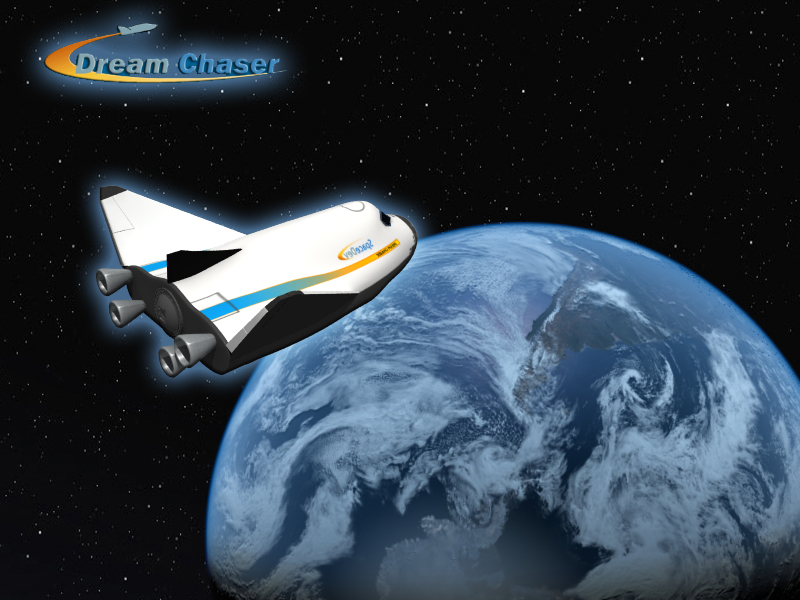
The
entrepreneurial space industry that has been emerging over the past years
is changing the course of how space is accessed, explored and utilized.
As this paradigm shift occurs, SpaceDev is in a unique position of leading
this charge with its broad technology base, its depth of capability, and
its entrepreneurial roots. The Advanced Systems group is chartered with
developing the advanced systems and technologies that are supporting this
sea-change in our industry.
A primary current focus of the Advanced Systems group
is an overall space transportation system based on the NASA HL-20 lifting
body spaceplane. Christened the Dream ChaserTM, it is being
designed to carry passengers and cargo in the sub-orbital and orbital flights
regimes, including flights to and from the International Space Station.
Leveraging the work performed on the NASA HL-20, the Dream ChaserTM
will provide a safe and affordable, solution for commercial space operations,
will launch vertically and land horizontally on conventional runways. Leveraging
the work performed on the NASA HL-20, the Dream ChaserTM provides
a safe and affordable solution for commercial space operations.
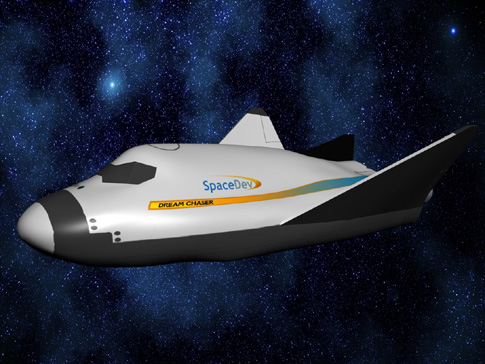 Dream
Chaser Video http://www.spacedev.com/
Click
on "videos", scroll down and click on "COTS ISS"
Dream Chaser: SpaceDev
Advanced Systems pdf (94Kb)
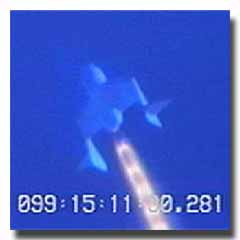 |
